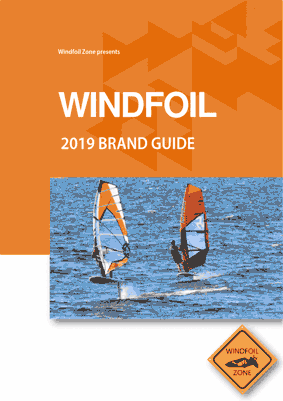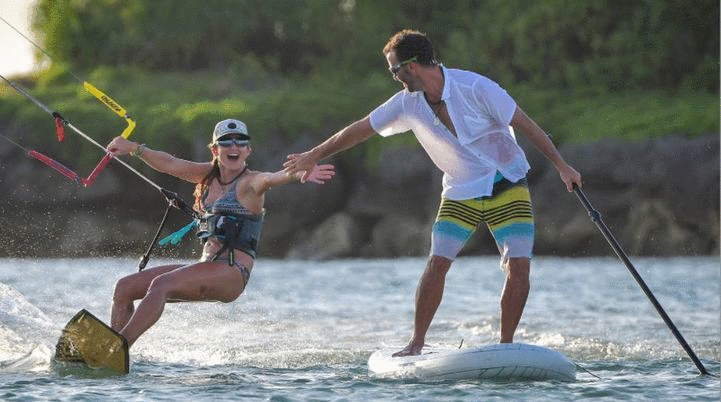How to Windfoil in Strong Winds
- Romain
- Jul 1, 2020
- 7 min read
Techniques and Tuning Advice for High Wind.
There has been a lot of focus on how it’s possible to get planning in light wind on a windfoil and comparing the most suitable equipment for windfoiling in less than 10 knots.
But don’t forget that windfoiling is not only just about light wind windsurfing, but much more. When you begin to feel more confident on your foil, you’ll start pushing the limits and exploring the potential of the foil.

Øyvind in the storm during the Norwegian championship
(Picture: Alf Magne Grindhaug)
It is actually not only possible to windfoil in strong winds, but it will become more and more the standard for the future with improving skills and using better adapted equipment, enabling the windfoiler to have a safer and more fun windfoiling experience in high winds.
Today we have discussed the subject with Øyvind Birkeland, a Norwegian windfoiler with almost 2 years of foiling experience, and he is used to strong winds as he lives on the windy, west coast of Norway.
He tells us about his experience from the recent Windsurf National Championship, and also gives us his tips and tricks to fly in strong winds.
WZ: Øyvind, thanks for answering our questions. Could you tell us a little bit about yourself and your daily life?
Øyvind Birkeland: I live North of Bergen on an island called Holsnøy, and I’m 36 years old. I started windsurfing four years ago because I wanted to find a fun way to keep fit and get off of the sofa.

I have always been a bit clumsy with sports, so I crashed a lot in the first year - bending booms and smashing boards. I soon found out that I liked windsurfing equipment and that made it possible for me to make sailing trips, and not just go back and forth. And also having a gear set that made it possible to sail more often.
So, for a year I had a phantom 320 board. After that, I had formula equipment for a year before I swapped it for foil gear. April 1st, 2017 was my first day on foil. I had just received a Lokefoil Envol, and modified an Isonic 110, and was determined to go flying. It was blowing at least 20 knots, but I rigged 5.4m and had fun right from the start. Flying and crashing.
In my daily life, there are three main W: My Wife, my Work and Windfoiling.
WZ: We have recently seen you on a foil during the Norwegian National Championship in slalom. Not only were you the only foil, but the competition also occurred during the first autumn storm with heavy conditions. Can you tell us more about that day?
ØB: Today, I only have my JP135 hydrofoil board. I do not have a regular windsurf board anymore. So, my only option was foiling. But in those conditions, I wouldn’t have dared to go out on slalom gear. For me, foiling was the most comfortable option.
Earlier this year, I entered another slalom regatta with my foiling equipment, and the wind was very strong as well. But that time the water was flat. During the National Championship in Karmøy, it was anything but flat. We had 30 knots of wind blowing straight onshore from the North Sea. It looked scary from the beach, so I was a bit skeptical. Especially because there were rocks in the water, big ones appearing above water, but also a few hidden ones.
But I think it is important to participate and have fun, no matter what the results end up being. So I forced myself out there. I have two 5.4m sails, a Neilpryde Atlas wave sail and a RS:Flight with 3 cambers; I went for the RS:Flight. I feel that it gives me more stability, like holding onto a wing. I have the NP F4 foil with a large and a small wing. The «right» wing used in a high wind slalom race is the small wing, because it has higher top speed. But I went for the larger one because I just wanted to fly slowly through the course, as crashing is a lot slower than sailing slow.

Windsurfing championship in Norway - Øyvind is the only one foiling.
(Picture: Alf Magne Grindhaug)
I went out, and it wasn’t too bad. I just took it easy, with the back foot in the centre of the board and kept the sail a bit open. On the reaches, the top guys would just fly away, but most of the others had a hard time on slalom gear and I could hold the same speed as them.
The first gybe mark was scary, but also fun. There were some solid waves around it, giving you a good push downwind in the gybe. In the beginning, I was falling often in the gybes, but so were most of the others as well. And after some time, I managed to get around the course without falling.
I finished all eliminations, and in the end, I finished in 12th position (out of 22!). I’m very happy about that!
WZ: Most people associate windfoiling with light wind windsurfing, but you seem to have quite some experience with heavier conditions as well. Most windfoilers would change to a regular board and fin as soon as the wind gets above 20 knots, but it sounds like you’d rather stick your foil. Correct?
ØB: Yes, in most conditions I sail better on the foil than with normal windsurf gear. I think you become a better foiler if you force yourself to go out in all conditions, not just the easy conditions. Last year, I was on holiday in France and the Netherlands, and I had only the foil board with me. The first day in the Netherlands it was blowing up to 40 knots and people were on 3m sails, I went out with the foil and a 4.2m.

WZ: We often get questions about windfoiling in strong winds and in particular how to tackle the gusts. Could you give us your best tips and tricks to windfoil in these conditions?
ØB: I think my best tip, unfortunately, is to just spend more time on the foil in all conditions. Then your body learns to “auto-correct” and balance the foil. Put on a helmet and go out.
If you do not want to go fast, you should just keep the back foot in the centre of the board and hold the sail open. With foiling you can cruise in slow speed comfortable even if your sail is way too big. Just open it and regulate the speed.
But if you have the guts to go fast, it is really a thrill to use the gusts for more speed. On a beam reach, it is challenging to keep things under control in a strong gust. My advice is to go deep downwind, hooked into the harness, and feet in the footstraps.
It may sound like an unusual angle, but it feels very good and controlled. If you start to feel that it is going too fast, just point deeper downwind and it will calm down. Careful not to point too much downwind though, as the speed will decrease too much and the board will start to wobble.

The video below shows Øyvind's downwind run from the upper left of the map to the bottom right. Deep downwind angle !
Windfoil downwind session!
When heading upwind I prefer to pull the outhaul tight, that way I feel it slices better through the wind.
In moderate conditions (10-18 knots) with my biggest sails (7.8m and 8.8m) I am comfortable sailing in all directions / angles with both feet in the straps and don’t mind some strong gusts. But in 30 knots, I am chicken: I take the back foot out of the footstrap and open the sail.
For tuning, I would say that it is important to tune the gear to have equal pressure on the feet. If you have too much pressure on the back foot, the nose will tend to dive down in every gust. You’ll need to find the right footstrap placement, rear wing trim, and mast foot position to affect this. Personally, I always keep the mast foot in the same position whatever the conditions, and the only thing I adjust is the outhaul tension. Adding more tension on the outhaul releases the pressure on the backhand when heading upwind.
It’s also natural to fly a bit lower when it’s very windy, as it can get a bit scary, but I always try to be high enough on the foil to avoid touching the chop.

WZ: Today windfoiling is mostly about light wind. Do you think that windfoiling in strong winds will be a thing in the future? How should the foiling equipment evolve in that case?
ØB: For sure. I think we already have several options within foiling in strong wind, and each of the options will become better and better.
The extreme options are to go out on race gear and sail upwind/downwind courses. Or you can go out with a small wing, and slalom sail.
The easier and more accessible option is just to cruise around with a small sail, doing gybe after gybe, on a freeride foil.
Thanks for answering our questions and giving your best tips on strong wind foiling!
Here is recap of Øyvind’s best tips to windfoil in strong winds:
Practice windfoiling in all kind of conditions, not only when the water is flat and the wind is light, and you will get better at controlling the foil.
Use a helmet and other adequate protective gear, such as an impact vest.
If you feel uncomfortable in the gusts, put the back foot in the centre of the board and hold the sail open. This will decrease your speed and you will be able to foil at a lower speed in a controlled manner.
If you are headed upwind, put more tension on the outhaul, it will release pressure from your backhand and help you heading upwind.
You can also try to go deep downwind in the gusts.
Tune the gear to have equal pressure on your feet: adjust your mast foot, your footstraps and the angle of the back wing to do so.
Do you have other tips on how to windfoil in strong winds?
Please give us your advice in comments below!
If you like our windfoil blog, don't forget to subscribe to our monthly newsletter and get the most recent articles right in you mailbox.







Comments